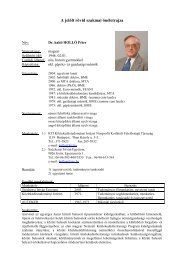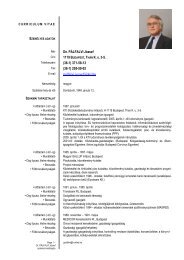VISION: Road Transport in Europe 2025 - FEHRL
VISION: Road Transport in Europe 2025 - FEHRL
VISION: Road Transport in Europe 2025 - FEHRL
Create successful ePaper yourself
Turn your PDF publications into a flip-book with our unique Google optimized e-Paper software.
The limited construction <strong>in</strong> Western <strong>Europe</strong> is likely to concentrate on areas where it can make a major impact<br />
<strong>in</strong> terms of reliev<strong>in</strong>g congestion. It is likely also to be associated with more novel design, <strong>in</strong>clud<strong>in</strong>g limited<br />
facility bridges or tunnels to provide local improvements <strong>in</strong> capacity, extended also to the provision of<br />
separate lanes for cars and trucks. The smaller and lighter cars will have the use of car-only lanes on double<br />
decks either above the road surface or <strong>in</strong> tunnels. This will be made possible by advances <strong>in</strong> tunnel technology<br />
and by the <strong>in</strong>clusion of all costs <strong>in</strong> scheme appraisal which will make tunnels relatively more attractive. Where<br />
new roads are required or exist<strong>in</strong>g roads replaced, novel methods of road construction such as those currently<br />
be<strong>in</strong>g <strong>in</strong>vestigated <strong>in</strong> the Netherlands are likely to be developed and used <strong>in</strong> some applications. There will<br />
<strong>in</strong>clude modular construction that enables roads to be constructed off-site. Once <strong>in</strong> position novel methods of<br />
overlay such as asphalt carpets which can be rapidly laid will be employed. The units may conta<strong>in</strong> preformed<br />
voids for utilities which are accessible without disrupt<strong>in</strong>g traffic and built <strong>in</strong> dra<strong>in</strong>age systems.They will also be<br />
designed to absorb noise thus reduc<strong>in</strong>g the impact of vehicles on the surround<strong>in</strong>g community. A further<br />
potential capability is to <strong>in</strong>corporate a facility for collect<strong>in</strong>g and stor<strong>in</strong>g energy from solar radiation.<br />
Recycl<strong>in</strong>g will be the norm. Replacement of roads at the end of their life will <strong>in</strong>volve substantial re-use of the<br />
exist<strong>in</strong>g material, possibly be<strong>in</strong>g cast <strong>in</strong>to the modular units described above, and the use of raw materials will<br />
be m<strong>in</strong>imised.<br />
Thus, to summarise, we anticipate significant physical construction <strong>in</strong> central and Eastern <strong>Europe</strong>, and rather<br />
more limited supplement<strong>in</strong>g of networks <strong>in</strong> western <strong>Europe</strong> by targeted and sometimes novel additions to<br />
physical capacity. Overall, the growth of road-based multimodal corridors coupled with grow<strong>in</strong>g hubs of<br />
urban and suburban development will beg<strong>in</strong> to reconfigure surface transport to some degree. In twenty years<br />
the advancement <strong>in</strong> this direction cannot be complete, but coupled with changes <strong>in</strong> communications it will<br />
have significant impact on both mass movement and on the travell<strong>in</strong>g experience of <strong>in</strong>dividuals.<br />
Changes <strong>in</strong> Land Use and Development<br />
There is likely to be a net movement towards urbanisation and the<br />
growth of city dwell<strong>in</strong>g, especially perhaps <strong>in</strong> Eastern <strong>Europe</strong>,<br />
accompany<strong>in</strong>g a relative decl<strong>in</strong>e <strong>in</strong> the availability of services,<br />
employment opportunities and transport supply <strong>in</strong> rural areas. Cities<br />
will see some re-urbanisation, as previously derelict or low-quality<br />
<strong>in</strong>ner areas are refurbished and gentrified, but overall there will be a<br />
relative shift <strong>in</strong> the location of activities (hous<strong>in</strong>g, <strong>in</strong>dustries, retail<br />
and other services) towards the peripheries of cities, exacerbat<strong>in</strong>g<br />
urban sprawl.<br />
27






